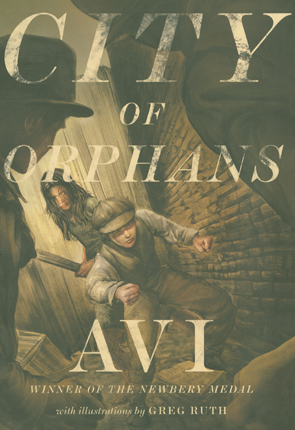Full Text Reviews: Booklist - 08/01/2011 *Starred Review* Dickensian street action comes to New York’s Lower East Side in this gripping story, set in 1893, about newsboy Maks, 13, who feels “hungry twenty-five hours a day.” After rescuing a filthy, homeless girl, Willa, Maks takes her to the crowded tenement he shares with his struggling Danish immigrant family. Pursued by Bruno, the leader of the Plug Ugly street gang, Maks is desperate to save his sister, Emma, who was imprisoned after being falsely accused of stealing a watch from the Waldorf Hotel, where she worked as a cleaner. Just as compelling as the fast-moving plot’s twists and turns is the story’s social realism, brought home by the contrasts between the overcrowded, unsanitary slums (“No water, gas, electricity”) and the luxurious Waldorf. Then there are the unspeakable conditions in prison, where, even as a prisoner, Emma must pay for food. Avi writes in an immediate, third-person, present-tense voice, mostly from Maks’ colloquial viewpoint (“He’s full of heartache, but no one is seeing it”), with occasional switches to Willa and to the young gangster leader. Threading together the drama are tense mysteries: Is Willa really an orphan? Who stole the watch? Pair this riveting historical novel with Linda Granfield’s 97 Orchard Street, New York: Stories of Immigrant Life (2001), a nonfiction account of Lower East Side tenements. - Copyright 2011 Booklist. School Library Journal - 08/01/2011 Gr 6–8—Maks Geless, 13, and his family live in a tenement in 1893 New York City. His father and older sister work in a factory; another sister works as a maid at the new Waldorf Hotel; his mother takes in laundry; and his younger brothers are still in school. Maks works as a newsie, selling newspapers on street corners. Lately he has been fighting off a gang that is trying to steal his earnings and he has found an unlikely defender in Willa, a homeless girl his age. After his sister is accused of theft at the Waldorf and awaits trial in prison, Maks, with help from Willa and a mysterious detective, seeks to prove her innocence and defeat the gang. Avi gives his omniscient narrator the voice of an old-time movie tough guy, complete with "ain'ts" and dropped first letters ("'specially," "see 'em," "'bout"). He paints a colorful, exciting picture of city life at the turn of the last century, while not shying away from its hardships. While guests at the Waldorf live in luxury, Maks's family deals with illness, filth, and death. The plot moves swiftly, covering much in just five days. The narrative wraps up, like a gangster movie, with a shoot-out at the Waldorf. An author's note grounds the tale in history, and Avi offers additional reading and viewing options. Ruth contributes several fine pencil sketches of the main characters, placing them nicely in their environments.—Geri Diorio, The Ridgefield Library, CT - Copyright 2011 Publishers Weekly, Library Journal and/or School Library Journal used with permission. Bulletin for the Center... - 11/01/2011 The Geless family, Danish immigrants in 1893 New York, needs every penny the parents and older children can make to keep their heads financially above water. Thirteen-year-old Maks Geless may feel Poverty breathing down his neck, but when he’s shaken down for his newsboy pennies by the Plug Ugly gang, he understands what true destitution looks like. He invites Willa, the ferocious street girl who champions him, home for a meal, only to walk into a family crisis: his older sister Emma has been accused of stealing a gold watch from a room at the Waldorf Hotel, where she’s a chambermaid. Now the family is short a vital income, Emma needs money for food in prison and for a lawyer, and the Plug Uglies are still threatening Maks. Inspired by the sensational detective stories that a boarder in the Geless household reads aloud each evening, Maks and Willa seek the services of crotchety, consumptive Bartleby Donck, a private investigator who pulls in a favor to get Maks a job at the Waldorf and then directs the children’s sleuthing activities. Although the matter of the purloined watch is set up as a mystery, there’s little tension or intrigue in the search for clues, and the villain’s identity comes freighted with more pathos than surprise. Tenement life among the working poor is of more interest, and readers who expect a work of historical fiction are likely to be better satisfied than those who seek a crime thriller. A brief list of materials for further reading and viewing, including several titles written for children (though not identified as such), is appended. EB - Copyright 2011 The Board of Trustees of the University of Illinois. Loading...
|



